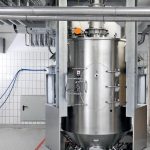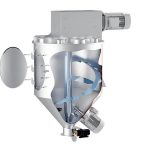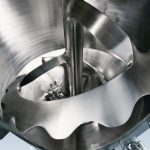Flavour specialist Symrise manufactures the most diverse powdery ingredients for the foodstuffs industry. Amongst other things, the company uses a conical mixer from Amixon for this purpose. The throughput time has been reduced by up to 25 % and premixing omitted as an additional process step.
Author Markus Strehlitz Freelance journalist
Symrise produces flavours and functional ingredients for foodstuffs. The Holzminden company often only has a very short time frame to do this. “We have to respond extremely fast to changing customer requirements. Our reaction times are no more than a few weeks, including purchasing the raw materials”, says Dr. Ludwig Tumbrink, Supply Chain Director in the Flavour & Nutrition Division at Symrise.
Suitable equipment is vital in order to be able to produce flexibly and quickly. Above all, the mixer must withstand the high stresses that prevail. Symrise relies on a conical mixer from Amixon. The mixing container is designed as an upright cone with a cylinder on the top.
“Vertical mixing systems have an advantage over horizontal apparatus”, explains Professor Rainer Barnekow of the University of East Westphalia-Lippe. “They are more flexible with respect to variable batch sizes.” In other words, even if the mixer is only 25 % full, it supplies the same mixing qualities as when it is 50 or 70 % full. The Amixon conical mixer supports any filling level from 5 to 100 %. “Users thus have a variable working area at their disposal”, adds Klaus Meyer, responsible for sales and technical consulting at Amixon. “They’re not tied to minimum quantities.”
This has a practical benefit for Symrise. Thanks to the conical design and low minimum volume, the premix – consisting, for instance, of carriers and liquid additives – can actually be made in the apparatus. At first, only a small amount is placed in this apparatus in order to obtain a premix by means of intensive deagglomerating preparation. More components are then added. In the final step, sensitive, lumpy goods such as visible spices can be gently folded in with an ideal mixing quality. This saves Symrise a further intensive mixer for producing the premix as well as an additional process step.
“Using the conical mixer has enabled us to reduce the costs for manufacturing our prod-ucts”, Tumbrink continues. In addition, the order throughput time for difficult products has been shortened by 20 to 25 %. According to the Supply Chain Director, the mixer can be retooled quickly whenever the product needs to be changed. Symrise manufactures two or three different products per day with this apparatus.
Broad range of applications
“Product diversity is one of the challenges in the flavour industry”, Tumbrink explains. Symrise produces powders in a variety of flavours from sweet to spicy. A paprika powder, for example, can consist of up to thirty different components. All these different components have different properties and bulk densities that must be mixed homogeneously.
“Our mixers must be able to manufacture both free-flowing and sticky products”, he contin-ues, “and they must be able to process both solid and liquid components without lumps.” “Modern mixers have to cover the broadest possible range of applications”, Barnekow confirms. Symrise offers more than a thousand products in powder form alone. Most of them are manufactured individually for a particular customer. The majority are complex structures composed of sensitive components. Tumbrink: “We therefore have to mix as quickly, but also as gently, as possible”. Particle destruction and temperature rises must be avoided, and the mixer must additionally be designed with this in mind.
Not only the flavours have to be preserved but also the health of consumers. For quite some time now, the trend in the foodstuffs industry has been towards products with reduced fat, sugar and salt for this reason. Manufacturers have gone over to using new carriers such as cereal flours to obtain their flavours. However, the properties of these substances are not the same as those of crystalline carriers such as salt. “That means increased demands on the mixing equipment”, says Tumbrink.
At the same time, flavours are not just there to cater for consumer tastes. In the foodstuffs industry the functionality of the products is equally decisive. “For example, our customers expect a free-flowing powder that can be processed further in their automated plants without a hitch”, he explains. Aspects like these have gained in importance over the last few years.
“Mixing used to be simply about combining different components”, Barnekow adds. Today, value creation results from functional mixing, in other words the selective adjustment of certain properties such as good bulk material behaviour. “Functional mixing is a highly complex process.”
Practical tests at the service centre
Before deciding in favour of this particular system, those responsible tested the apparatus at the Amixon technical service centre in Paderborn. “Ultimately, this kind of problem can only be solved empirically”, Barnekow comments. “You have to go to the lab and evaluate which is the most suitable device.” No simulation programme can ever replace practical testing. According to Barnekow, however, there is one thing that any decision-maker should never forget: “There is no such thing as an all-rounder or a mixer that is omnipotent”. Each apparatus must be adapted to the specific application portfolio: amongst other things, this concerns the selection of the mixing tool or the use of additional deagglomeration tools. “Basically, no mixer is absolutely identical to any other”, says Meyer, the Amixon sales manager.
Smooth integration in the process
The mixer in Holzminden, which was explicitly tailored to Symrise’s needs, is integrated in an automated production line. In some Symrise divisions the degree of automation is as high as 80 %. To ensure smooth integration into the process, it is also important that the mixing system should be robust and not require too much technical knowledge to use. “We need a system that is intuitive to work”, Tumbrink emphasises. Operators in foreign countries are often less well qualified than the highly skilled staff in Germany. “It’s a big advantage for us that the technology can be deployed at any location without any problems.” He also appreciates the fact that the mixer was designed with easy cleaning a top priority.
Both wet and dry cleaning are practised at Symrise, depending on the order in which the flavours are produced. Meyer believes that, in addition to the high-quality surfaces of the Amixon mixer, it is above all the conical design that facilitates cleaning: “The central downward discharge ensures good emptying of residues”. In its product documentation Amixon promises up to 99.98 % residue discharge. The amount of loss that needs to be allowed for in each individual mixing job is therefore lower. In practice, this means fewer raw materials, less waste and a reduced burden on the environment from cleaning water.
cpp-net.com/0114444
Share:









